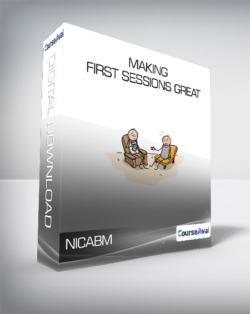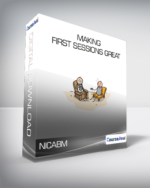We invite you to register for this comprehensive training program without any risk. Unless you are completely satisfied, we will refund your money. Just let us know within 30 days from the date of registration. We are that confident that you will find this information to be more than you expected.Purchase NICABM – Making First Sessions Great courses at here with PRICE $197 $42NICABM – Making First Sessions GreatHow To Make Your First Session So Effective That Your Clients Leave Full Of Hope, Commitment To Change and Motivation To Do The WorkMore than 20 percent of clients won’t come back for a second session.That’s why first sessions really matter.That first meeting with a new client can determine whether or not they continue with treatment.So how do we make sure our first session is so powerful and so effective that our clients leave with hope, commitment and motivation to do the work?We asked 17 top experts to tell us what they think about when approaching a first session. What are their goals? How do they start? How do they work with the challenges that first sessions present? What are the warning signs they look for?They shared their insights and strategies – ones that you can apply to your work with clients today.Successful Strategies to Make Your First Sessions Greatlanting Seeds for Success in the First SessionLynn Lyons, LICSW Ron Siegel, PsyDOne simple but effective pre-session communication that can prime your work for successHow to have clients leave your first session brimming with hope and confidenceOne adjustment to your initial client assessment that can boost engagement and motivationirst Sessions with Challenging ClientsMarsha Linehan, PhD Ron Siegel, PsyDRick Hanson, PhDA first session compatibility check to gauge proper practitioner/client fitThe crucial empathic connection that can defuse a client’s initial defensivenessOne change to a behavior-modeling technique that can save your client from feeling criticizedHow to present feedback so the client doesn’t fall prey to harmful self-blameHow to Manage a Client’s Expectations for TreatmentChristine Padesky, PhD Rick Hanson, PhDAn immediate way to remedy a new client’s unrealistic expectations for therapyOne approach to address a client’s low motivation (and turn it into a more fruitful first session)What a Client’s Nervous System Needs in the First SessionStephen Porges, PhD Kelly McGonigal, PhDThe specific parts of your clinical environment that may be triggering your client’s defensivenessHow white noise generators can actually drive up your client’s fear and arousalOne way your voice can open the portal of presence and engagement with a new clientHow to Foster Greater Client Disclosure for More Accurate DiagnosesShelly Harrell, PhD Ron Siegel, PsyDHow to dilute the power dynamic in a first session so the client feels comfortable taking risksHow to work with the hidden cultural factors that may be sabotaging your first sessionOne simple question at the beginning and end of a first session that can lead to more accurate diagnosesHow to Address Common Warning Signs in the First SessionRon Siegel, PsyD indel Segal, PhDRick Hanson, PhDThree warning signs that can derail a successful first sessionWhy a client’s oversharing in a first session may signal a potential early dropoutHow to disarm the first sign that a client may be idealizing your workA Body-Focused Approach to a Successful First SessionPat Ogden, PhD Kelly McGonigal, PhDHow a new client’s body movement can reveal hidden sources for healingOne way to uncover and expand actions of hope that may be trapped in the client’s nervous systemAn important reframe in the first session that can help increase a client’s agency in their healingOne way to broaden a client’s “aspirational window” so they leave the first session with a sense of hopeKey Skills to Alleviate a New Client’s Feeling of VulnerabilityDan Siegel, MD Kelly McGonigal, PhDRichard Schwartz, PhDHow to keep a client’s social engagement system from thwarting the first sessionNine practitioner behaviors that can directly affect clinical outcomesHow to fend off attacks from a client’s most vulnerable parts when they turn protectiveHow to Build Hope in the First SessionBill O’Hanlon, LMFT Rick Hanson, PhDA counterintuitive way to immediately connect clients to feelings of hope and possibilityHow to expand a client’s capacity to see beyond their problem and into a better futureA first session approach to help shift a client’s negative mindsetStrengthening a New Client’s Commitment to TherapyRick Hanson, PhD Kelly McGonigal, PhDThe “three pile” approach to a first assessment that can reveal untapped opportunities for healingTwo unconscious judgments when we first meet someone that can block a therapeutic connectionWhy your client’s issue may stem from a “scaling” problem (and how to boost their commitment to improve it)How Your Opening Question Can Set the Tone for SuccessEllyn Bader, PhD Rick Hanson, PhDHow to phrase your initial greeting so it becomes a litmus test of the client’s motivationA practical strategy to help clients self-assess problematic behavior (and boost accountability)How to transform a tension-filled first session with couples into a positive commitment to problem-solvingHow to help clients “buy in” to doing the important work in your treatment planBuilding a Strong Therapeutic Bond That Will Last Beyond the First SessionBill O’Hanlon, LMFT Joan Borysenko, PhDKelly McGonigal, PhDHow to connect a new client’s talents to beneficial therapeutic experiencesThe conversational shift that marks the exact moment a client is ready for changeTwo important questions at the end of a first session to verify you (and the client) are on the right trackTwo Ways to Work with an Underlying Medical Issue in the First SessionRon Siegel, PsyD Dan Siegel, MDJoan Borysenko, PhDThe important first step when a client’s issue may have an underlying medical problemA vital query to help pinpoint the exact way a client’s problem is keeping them stuckThe five integral components of meaning to help shift a new client’s mindset about their experienceHere’s What You’ll Get:Everything is yours to keep forever in your professional libraryDownloadable videos so you can watch at your convenience, on any deviceAudio recordings you can download and listen to at home, in the car, at the gym or wherever you likeProfessionally-formatted transcripts of the sessions, to make review and action simpleTwo downloadable bonuses to help you work more effectively in a first sessionGet Three Bonuses to Help You Work More Effectively in a First SessionBonus 1How to Get a Reluctant Client to Come to TherapyLynn Lyons, LICSW Kelly McGonigal, PhDWhy Skillful Self-Disclosure Can Be Vital for Connecting with an anxious First-Time ClientOne Natural Yet Powerful Way to Enhance Empathy in a First SessionBonus 2Get NICABM – Making First Sessions Great downloadFirst Sessions with Couples – Part 1Sue Johnson, EdD Joan Borysenko, PhDWorking with a Couple’s Fears in the First SessionTwo Ways to Create a Safe Space for Both Partners in the First SessionStrategies for helping a Couple Feel Less Anxious During the First SessionFirst Sessions with Couples – Part 2Stan Tatkin, PsyD, MFT Rick Hanson, PhDOne approach for getting a Comprehensive Picture of a Couple in a First SessionHow to Categorize a Couple’s “Red Flags” in a First SessionKey Ways to Help Both Partners Lower Defenses in a First SessionBonus 3When to Disclose Personal Details in a First SessionShelly Harrell, PhD Rick Hanson, PhDOne approach to get a Better Sense of What’s Most Important to Your First-Time ClientThe 3 Types of Communication We Need to Keep in Mind during a First SessionOne strategy to Help a Client Feel More Relaxed in a First SessionWhy the Transcript Is Essential:The transcript makes it easy to go back and double check concepts, citations and names that are mentionedWe put in a table of contents to make it easy for you to find the exact part of the session you needHaving the concepts already written allows you to take notes on how you’re going to use the ideas rather than transcribing the ideasSome people simply learn better by reading than by listening or watchingYou will be able to print out and share techniques presented in the session with your patientsYou Are Protected ByNICABM’s Money-Back GuaranteeWe invite you to register for this comprehensive training program without any risk. Unless you are completely satisfied, we will refund your money. Just let us know within 30 days from the date of registration. We are that confident that you will find this information to be more than you expected.Purchase NICABM – Making First Sessions Great courses at here with PRICE $197 $42
 John Danaher – BJJ Gi Fundamentals – Passing the Guard
₹6,972.00
John Danaher – BJJ Gi Fundamentals – Passing the Guard
₹6,972.00
 Jon Benson – The Upsell Profit Formula
₹6,972.00
Jon Benson – The Upsell Profit Formula
₹6,972.00
NICABM – Making First Sessions Great
₹6,972.00






